

English Origins of Henry Doude. The English Origins of Henry Doude of Guilford, Connecticut Henry Doude left Kent, England during the “Great Migration” in 1639.
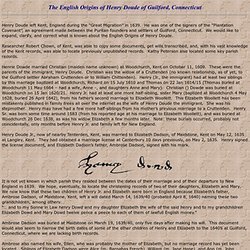
He was one of the signers of the “Plantation Covenant”, an agreement made between the Puritan founders and settlers of Guilford, Connecticut. We would like to expand, clarify, and correct what is known about the English Origins of Henry Doude. Researcher Robert Chown, of Kent, was able to copy some documents, get wills transcribed, and, with his vast knowledge of the Kent records, was able to locate previously unpublished records. Kathy Peterson also located some key parish records. Henrie Dowde married Christian (maiden name unknown) at Woodchurch, Kent on October 11, 1609. Wolslau Family. Janet's Genealogy. Like most Wiseman researcher I read Tom Chapman book “A Wiseman Story” date 1992. I even read Eugene Wiseman book on "the Wiseman family of North Carolina. " When I say read I mean but really reading it. I am redoing my webpage times in the last few years and will be redone many more times as new facts are unearthed.
I starting this time with William Wiseman Ledger, that he wrote himself. William Wiseman did the book for his son Davenport Wiseman who was moving away from home for parts west. William wrote: "Wm William,Lin (unclear) was born in City of London. It looks like someone wrote over and tried to chance it to 1736. William states I was born in City of London on Nov 2,1730/49 in St James’s Clerkenwell Parish. Christening in Saint James, Clerkenwell, London, England JOHN WISEMAN m'd MARY STORY on 29 SEP 1719 Saint Mary The Virgin At The Walls, Colchester, Essex, England Child WILLIAM WISEMAN Christening: 18 MAY 1725 Saint James, Clerkenwell, London, England Now we back to drawing.
Next 4. Tennessee Constitution, 1796. TNGenNet, Tennessee Law, The Early Days. We the People of the territory of the United States south of the river Ohio, having the right of admission into the General Government as a member State thereof, consistent with the Constitution of the United States and the act of cession of the State of North Carolina, recognizing the ordinance for the government of the territory of the United States northwest of the river Ohio, do ordain and establish the following constitution or form of government, and do mutually agree with each other to form ourselves into a free and independent State by the name of the State of Tennessee.
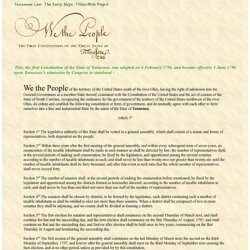
Article 1st Section 1st The legislative authority of this State shall be vested in a general assembly, which shall consist of a senate and house of representatives, both dependent on the people. Section 4th The senators shall be chosen by districts, to be formed by the legislature, each district containing such a number of taxable inhabitants as shall be entitled to elect not more than three senators. Article 2nd. Tracing the Scots-Irish. The answer seems obvious, but by the eighteenth century some of the restrictive laws had loosened.
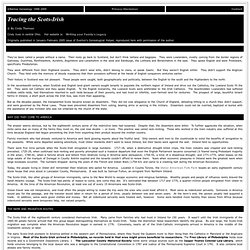
Despite that, the dissenters were bitter. To further aggravate the situation, when rents came due on many of the farms they lived on, the cost rose double -- or more. This practice was called rack-renting. Those who worked in the linen industry also suffered at this time because England had begun preventing the Irish from exporting their product beyond the mother country. Family members who had already ventured to America sent back glowing reports about the fruitful land. Today, the people living in Ulster still remember their relatives who sailed for America.
The Scots-Irish, like other groups of American immigrants, came to the New World to escape economic and religious hardships. Ocean travel was not inexpensive, and most often the people willing to make the trip were the ones who could least afford it. Full text of "History of Union County" History of Sangamon County. The History of Sangamon County Sangamon County become the 21st county in Illinois on January 30, 1821.
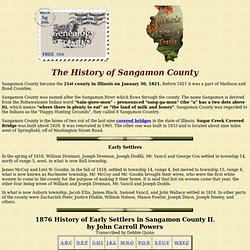
Before 1821 it was a part of Madison and Bond Counties. Sangamon County was named after the Sangamon River which flows through the county. The name Sangamon is derived from the Pottawatomie Indian word "Sain-guee-mon" - pronounced "sang-ga-mun" (the "a" has a two dots above it), which means "where there is plenty to eat" or "the land of milk and honey". Sangamon County was regarded to the Indians as the "Happy Hunting Grounds", they called it Sangamon Country. News394.pdf (application/pdf Object) MacKenzie Clan DNA Project. Clan MacKenzie DNA Project Results Report as of 14 February 2011 Y-DNA results: We can now see that the MacKenzie clan is composed of multiple patriarchs who migrated from different parts of the world to create the clan in Scotland.
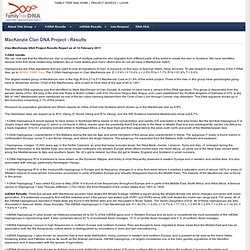
We have identified several lines that show relationship between two or more testers plus many others who do not yet have a MacKenzie match. Haplogroups are DNA signatures that are used to look at migrations of man. A resource on this topic is Spencer Wells, Deep Ancestry. To see research and graphics of the Y-DNA tree, go to ISOGG YSNP Tree. The largest related group of MacKenzie men is the Hgp R1b>L21>L513 MacKenzie Core at 21.8% of the entire project.
The Dalriada DNA signature was first identified by Mark MacDonald of Clan Donald. Research by population geneticist Jim Wilson reports an influx of Irish into Scotland which shows up in the MacKenzie clan as 8.8%. • Y-DNA Haplogroup T was called K2 prior to May 2008. Revolutionary War Soldiers Buried in Illinois.